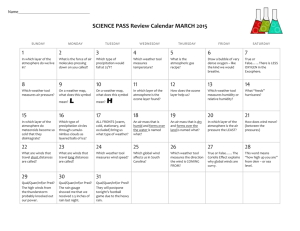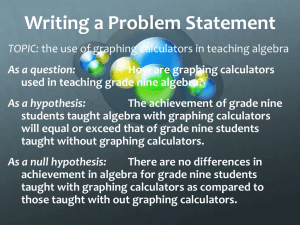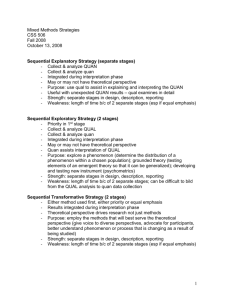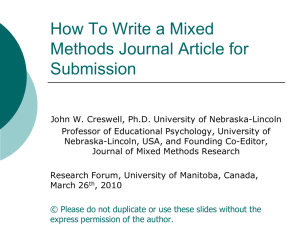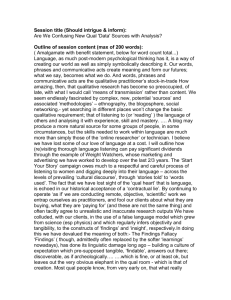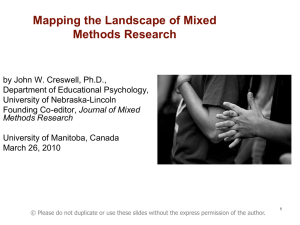Mixed Methods Research
advertisement
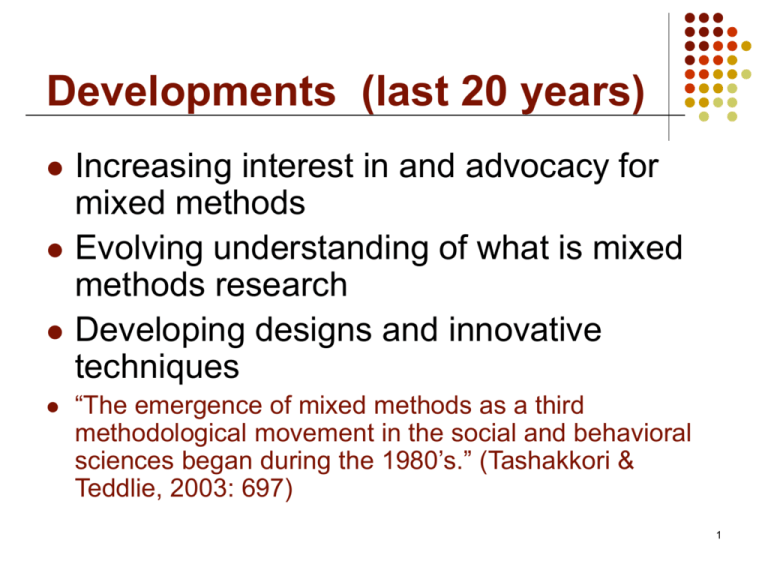
Developments (last 20 years) Increasing interest in and advocacy for mixed methods Evolving understanding of what is mixed methods research Developing designs and innovative techniques “The emergence of mixed methods as a third methodological movement in the social and behavioral sciences began during the 1980’s.” (Tashakkori & Teddlie, 2003: 697) 1 Development of NIH guidelines (1999) “Combining qualitative and quantitative methods has gained broad appeal in public health research.” (1999) - Mentioned several approaches for combining qualitative and quantitative research - Advanced considerations for deciding what model to use (literature available, prior studies, realistic design, expertise) - Suggested to describe each method thoroughly 2 Mixed Methods Research 14+ books on mixed methods research have been written since 1988 3 A New Journal Journals Devoted to Mixed Methods: Fieldwork Quality and Quantity Mixed Method Approaches Editors: John W. Creswell and Abbas Tashakkori Managing Editor: Vicki L. Plano Clark Email: vpc@unlserve.unl.edu 4 Conferences Mixed Methods Conference, Cambridge, England, July 21-24, 2008 Proposed mixed methods conference, Sydney, Australia, 2009 Discipline conferences with mixed methods papers 5 Critics (Creswell, 2007) Is there a post-positivist leaning to mixed methods? Howe, K. R. (2004). A critique of experimentalism. Qualitative Inquiry, 10, 42-61. Giddings, L. S. (2006). Mixed-methods research: Positivism dressed in drag? Journal of Research in Nursing, 11(3), 195-2003. Holmes, C. A. (2007). Mixed(up) methods, methodology and interpretive frameworks. Contributed paper for the Mixed Methods Conference, Cambridge, University, July 10-12, 2006. What are the limits for mixed methods research? Sale, J. E. M., Lohfeld, L. H., Brazil, K. (2002). Revisiting the quantitative-qualitative debate: Implications for mixed-methods research. Quality and Quantity, 36, 43-53. Leahey, E. (2007). Convergence and confidentiality? Limits to the implementation of mixed methodology. Social Science Research, 36, 149-158. Is there a dominant discourse in mixed methods research? • Freshwater, D. (2007). Reading mixed methods research: Contexts for criticism. Journal of Mixed Methods Research, 1(2), 134-146. 6 Mixed methods is not that different from other methods Identifying a research problem Reviewing the literature Identifying a purpose and stating questions Collecting data Analyzing and interpreting data Reporting and evaluating the study 7 Mixed Methods within Designs Ethnography Qual ----- Quan Case Study Research Qual----- Quan Narrative research Qual-----Quan Experimental research Qual---- Quan 8 What is this Method Called? Multi-method Triangulation Integrated Combined Quantitative and qualitative methods Multi-methodology Mixed methodology Mixed-method Mixed research Mixed methods 9 Mixing (How) Converge data: Qual Results Quan Connect data: Qual Quan Results Embed the data: Quan data Qual data 10 Mixing – Why? Validity – to corroborate quan and qual data Offset – offset weaknesses of quan and qual and draw on strengths Completeness – more comprehensive account that qual or quan alone Process – quan provides outcomes; qual, the processes Explanation – qual can explain quan results or vice-versa Unexpected results – surprising results from one, other explains Instrument development – qual employed to design instrument Credibility – both approaches enhance integrity of findings Context – qual provides context; quan provides general. Utility – more useful to practitioners 11 Purist Stance Smith & Heshusius, (1986) “Incompatibility thesis” “The contention of this paper is that the claim of compatibility, let alone one of synthesis, cannot be sustained.” (p. 4) 12 “Single” Paradigm Stance Pragmatism (Tashakkori & Teddlie, 2003) Focus on research question What “works,” consequences Multiple methods – large toolkit Transformative (Mertens, 2003) Transform lives of underrepresented, marginalized groups Incorporate this focus into all phases of research 13 Developing Designs and Innovative Techniques Key Developments Notation Typologies Diagrams of procedures Complex evaluation models Reconceptualizing designs Emergence of innovations in procedures Unusual blends Methodological issues Data analysis techniques Presentation techniques 14 Preliminary Design Considerations (Morse, 1991) Approach Type Purpose Limitations Resolutions QUAL + quan Simultaneous Enrich description of sample Qualitative sample Utilize normative data for comparison of results QUAL Sequential Test emerging H, determine distribution of phenomenon in population Qualitative sample Draw adequate random sample from same population QUAN + qual Simultaneous To describe part of phenomena that cannot be quantified Quantitative sample Select appropriate theoretical sample from random sample QUAN Sequential To examine unexpected results Quantitative sample Select appropriate theoretical sample from random 15 sample quan qual Parsimonious Designs (Creswell & Plano Clark, 2007) Concurrent Mixed Methods Designs Triangulation Design QUAN Data & Results Interpretation QUAL Data & Results Embedded Design QUAN Pre-test Data & Results Intervention qual Process QUAN Post-test Data & Results Interpretation 16 Sequential Designs Mixed Methods Designs Explanatory Design QUAN Data & Results Following up qual Data & Results Interpretation Exploratory Design QUAL Data & Results Building to quan Data & Results Interpretation Sequential Embedded Design Beforeintervention qual QUAN Intervention Trial Afterintervention qual Interpretation 17 Example of A Diagram 18 Complex Mixed Methods Evaluation Designs (Nastasi, Hitchcock, Sarkar, Burkholder, Varjas & Jayasena, 2007) Study of mental health interventions for youth in Sri Lanka
